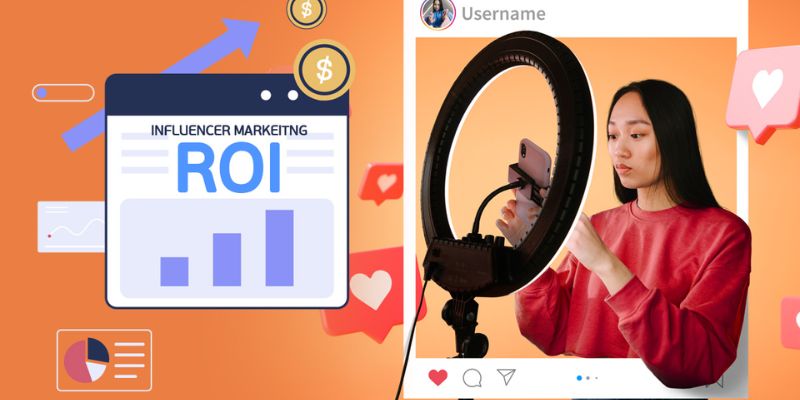Measuring the ROI of influencer marketing for tech brands isn’t just a trend; it’s a must. Imagine knowing every dollar’s worth when your brand teams up with the movers and shakers of the tech world. I’m here to peel back the layers of clicks, likes, and hashtags to show you how every post can fuel your brand’s rocket ship. Think measuring success is like catching smoke with your bare hands? Think again. It’s time for the scoop on how to translate influencer buzz into a language of crisp numbers that make sense – and cents. Join me as we dive into the nitty-gritty of aligning KPIs with your tech brand’s goals and witness the power of social analytics in action. Let’s make every partnership count and steer clear of guesswork. Ready to unlock the secrets of strategic influencer evaluations? Buckle up; it’s crunch time.
Understanding the Fundamentals of Influencer Marketing ROI in the Tech Industry
Defining Key Performance Indicators (KPIs) for Tech Influencer Campaigns
When we talk about influencer marketing, we often throw around the term “ROI”. But what does that mean in the tech world? ROI stands for “return on investment.” It tells us how much bang we get for our buck. To really know if our influencer partnerships work, we focus on KPIs. KPIs are like secret codes that unlock the mystery of marketing success.
For tech brands, KPIs might include how many people clicked a link, how many bought a product, or how our brand’s buzz grew online. These metrics are like gold. They show if the money we spend helps our brand shine in the tech market. If we see more sales after an influencer talks about our product, we know they rock their role.
The Role of Social Media Analytics in Measuring Tech Brand Success
Counting likes and shares can feel like a game. But it’s more than that for tech companies. It’s a treasure hunt for success clues. Social media analytics let us see the impact of influencers on our brand. Not just fluff, but real, hard stats that tell us if we’re winning the game.
Say we partner with a tech influencer who tweets about our latest gadget. Our tools can track how many folks go from that tweet to our website. If that number’s high, we’re on to something good. We can even see if those visitors stick around or bounce. Stick means the influencer’s doing a stellar job.
Small actions like a retweet or a comment can add up to something big. They can mean a customer tells a friend, and that friend tells a friend, and bam – our tech product’s the talk of the town. We keep score with metrics like engagement rate and conversion rates. And if the numbers say “good job,” we know we’re getting the return on our influencer spend.
Remember, though, that not all that glitters is gold. A high number of likes doesn’t always mean sales are soaring. That’s why we get down to the nitty-gritty with attribution modeling. This means we follow the breadcrumbs back from a sale to the influencer who brought the customer to us.
In all, what counts is understanding the connection between a retweet, a new follower, or a #coolhashtag and our brand’s bottom line. It’s a puzzle for sure. But when we lay out the pieces right – with the right influencers, the right tech, and the right strategy – the picture is clear. The treasure isn’t just more sales; it’s knowing the path we took to find them was worth every step.

Strategic Attribution and Evaluation Techniques for Influencer Partnerships
Advanced Attribution Models for Influencer Campaigns
Smart folks say, “You can’t manage what you don’t measure.” This rings true in influencer marketing, too. Now, we look at fancy math called attribution models. They show us which influencers help us sell our tech stuff. Think of it like a scoreboard. It says who sends us buyers and who just looks good. Let’s dive in.
How does this work? Imagine a customer sees a post by a tech influencer about a cool gadget. Later, they buy it. The model gives points to the influencer for helping make that sale. This way, we know our money’s well spent.
We use stuff called key performance indicators (KPIs). It’s like a list of things that tell us if we’re winning. They answer questions like:
- How many folks did our influencer reach?
- Did they get people chatting and liking posts?
- Most of all, did people buy because of them?
KPIs are super handy when you want to see if your influencer pals are doing their job right. We keep an eye on clicks, likes, shares, and, oh yes, sales. These numbers do not lie.
Assessing the Long-term Value of Influencer Relationships
Let’s talk long-term, friends. Some things get better with age, like fine wine or a good friendship. Same goes for influencer ties. When influencers and brands click, it can be magic! Over time, trust builds, and their fans start to love your brand, too.
So, how do we peek into the crystal ball of the future? We ask: Will this influencer keep making us shine for years? To know for sure, we need to keep tabs on a few things. They include:
- Engagement rates: Are people always talking and excited?
- Cost-per-acquisition: How much cash are we dishing out to gain a new buyer?
- Conversion rates: Out of all the folks reached, who’s pulling out their wallet?
We also compare the influencer stuff to old-school ads. Which one’s the champ? Do people dig influencers more than a billboard? We search for answers in the return on marketing spend. Think of influencers as seeds. The right ones sprout into money trees!
And it’s not just a numbers game. We feel the vibe, too. We ask, do the influencer’s values vibe with ours? Do their fans dig what we’re about?
When they do, we form a squad. Like tech jedis armed with the force of analytics, we conquer sales goals one post at a time. And that’s the tale of how we bring in those precious dollars with the art of influencer partnerships.

Comparative Analysis: Influencer Marketing vs Traditional Advertising in Tech
Evaluating Earned Media Value Versus Direct Response Outcomes
Measuring influencer marketing’s worth is tricky. We look at what people say. We call this ‘earned media’. It’s like having customers shout your brand’s name from rooftops. Now compare this with ‘direct response’. That’s when viewers click a link or buy a product right away.
In tech, these voices can be louder than ads. Tech folks trust other tech folks. When a tech influencer shares your product, their words carry weight. They’re seen as honest, not pushy like ads.
But how much is that tweet or blog post worth? We find out by tracking how often people mention your brand because of that influencer. That’s your earned media value. More mentions mean a better return on your influencer spend.
Calculating Cost-Per-Acquisition and Customer Lifetime Value
Now, let’s talk money. Two big things matter here: how much you pay to get a new customer (cost-per-acquisition, or CPA) and how much they’ll spend over time (customer lifetime value, or LTV).
Influencers can help lower your CPA. Their fans often turn into your customers for less money than ads cost. That’s because influencers talk right to your ideal users, those tech-savvy folks who want your stuff.
Next, LTV. That’s all about the long game. A customer might buy once because of an influencer. But will they buy again? If they do, that’s good news for your LTV. Influencers can keep folks coming back by reminding them why your tech is top-notch.
So, we measure. We crunch numbers. We see how influencer marketing stacks up against ads. Every like, share, and click counts. Tech brands win when they know how these actions turn into sales.
KPIs like engagement rate and conversion rates come into play. They help us know influencer content performance. This isn’t just about popularity. It’s about actions that ring the cash register.
And hey, the tech sector is full of smart cookies. You guys get it. With the right social media analytics, you can see just how much bang you’re getting for your buck. Then, you fine-tune. More of what works, less of what doesn’t.
In the end, it’s all about balance. Tech influencer partnerships bring both noise and numbers. So, roll up your sleeves and get deep into your ROI measurement strategies. That’s how you’ll know if influencers or ads deliver better returns for your tech brand.

Optimizing Tech Brand Growth Through Influencer Engagement
Demographic Targeting and Hashtag Analysis for Tailored Campaigns
When tech brands pair up with influencers, they strike gold. The key? Pinpointing who’s tuning in. Imagine rolling out a shiny gadget. You’d want folks who love tech to perk up their ears, right? That’s where demographic targeting steps in. It’s like having a treasure map to mark ‘X’ on the spot where potential fans and buyers hang out.
Hashtags tie it all together. Think of them as beacons flashing in the social media night sky, guiding users to the treasure—your product. Track these tags, and you’ll know if your influencer’s posts are hitting the jackpot or missing the mark.
End-to-End Efficacy of Influencer Collaborations and Conversions
Now, let’s chat about the full journey—from when an influencer first yaps about your gadget until a curious onlooker becomes a happy customer. This full trip is what we call ‘end-to-end efficacy.’ It’s a measure of how well the influencer’s shout-outs turn into actual sales.
The best part? Every click, like, and purchase can be traced, making it clear how much bang you’re getting for your buck. Is each dollar spent turning into a crowd of eager buyers? That’s what we’re after. We call this journey the influencer collaboration and conversion path, and it’s packed with juicy data that tech brands can’t afford to ignore.
By scrutinizing this path, we uncover a wealth of insights. We look at conversions, which tell us how many of those digital nods and online winks turned into sales. It’s all about knowing if those social media posts are like silent salespeople, working in the background, convincing folks to take the leap from ‘just looking’ to ‘shut up and take my money!’
Through precise tracking and a steady gaze on KPIs like engagements and click-through rates, tech brands can slash through the bewildering jungle of digital promos and stake a clear claim on the influencer marketing treasure trove. The goal is to refine their strategy, ensuring every influencer partnership yields a bounty of benefits and steers the brand toward unrivaled growth.
In this post, we dove into influencer marketing ROI in the tech world, showing you how to spot the best methods to track your success. We laid out the critical KPIs, looked into the power of social media analytics, and offered up advanced ways to attribute your gains right back to the influencers. We even put influencer marketing head-to-head with traditional ads, so you can see the real deal on costs and what you get back over time.
Now, it’s clear that linking up with the right tech influencers can take your brand places. By tuning into what your audience loves and turning insights into action, influencers can boost your growth big time. And that’s not just talk; the stats and strategies we broke down prove it’s time to team up with influencers. They’ve got what it takes to help you reach the folks you want and keep them coming back for more. Implement these tips, and watch your brand level up!
Q&A :
How do you calculate the ROI of influencer marketing for tech companies?
To calculate the ROI of influencer marketing for tech brands, begin by defining clear goals and set key performance indicators (KPIs) such as website traffic, lead generation, or sales conversions attributable to the influencer’s campaign. To calculate the actual ROI, use the formula: (Return – Investment) / Investment x 100. The Return is the revenue from sales influenced by the marketing activity, while Investment accounts for all costs related to the influencer campaign.
What metrics are important for evaluating influencer marketing success in the tech industry?
Key metrics to evaluate influencer marketing success in the tech industry include engagement rates (likes, comments, shares), conversion rates, click-through rates (CTR), and customer acquisition costs. Additionally, track brand sentiment, content reach, and the quality of leads generated to fully assess the performance of the influencers.
Can influencer marketing be cost-effective for tech brands?
Influencer marketing can be highly cost-effective for tech brands if strategically implemented. It allows for targeted outreach to specific audiences that trust the influencer’s recommendations. When compared to traditional advertising costs and the potential for precise audience targeting, influencer marketing often yields higher engagement and conversion rates, making it a cost-effective solution.
How to align influencer marketing strategies with tech brand goals?
To align influencer marketing strategies with tech brand goals, identify the objectives such as brand awareness, product education, or direct sales. Choose influencers whose audience demographics and values resonate with the brand. Collaborate with influencers to create content that highlights the brand’s message and uses clear calls-to-action to achieve the set objectives.
What challenges do tech brands face in measuring influencer marketing ROI?
Tech brands often face challenges in measuring influencer marketing ROI due to the complexity of assigning value to non-purchase actions, like engagement, and the long sales cycles associated with tech products. Additionally, tracking the customer journey across multiple platforms and touchpoints can be difficult, which may lead to an incomplete understanding of the campaign’s effectiveness. Multi-channel attribution models and advanced analytics are essential for overcoming these challenges.



